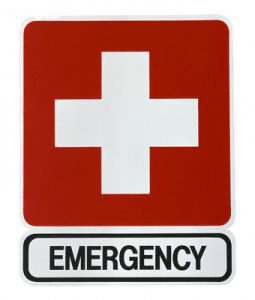Articles
Details Matter: Safety & Emergency Protocols

We all know that safety and security protocol is critical to our operations as a basic standard of care. If you have good systems, you are requiring all pertinent staff to be CPR and AED certified. You are most likely having all staff participate in an initial emergency response protocol training at time of hire. And you may have staff participate in refresher trainings on the club’s emergency protocols on a somewhat regular basis such as quarterly, or when you have an all-staff meeting. Even the most diligent of staff aren’t always prepared to be emergency first responders. It’s not their everyday job or even something they are trained on in real-life situations where panic, emotion, urgency, and action all come together.
As someone that has performed CPR on two victims – unsuccessfully, unfortunately – I know first-hand the emotion that goes into these types of situations. I taught CPR for over 10 years with the American Red Cross and was recognized as my county’s Safety Instructor of the Year. I was as prepared as one could be as a health club operator. But no matter what level of training someone has, it is a traumatic, emotional experience to perform CPR or to administer the use of an AED. Not to mention the countless other first aid and/or life and death situations that our team members may be called upon to handle in their roles within the club. Safety and security response preparation should be a fundamental part of our operations in order for our staff to truly be as prepared as possible in the event of an emergency.
Below are some examples of emergency situations and operational standards to consider. These are not all inclusive, rather some key suggestions/guidelines to enhance your current safety and security response protocol.
Evacuation:
- Post your evacuation plan in all key employee areas of the club;
- Ensure the plan indicates where AEDs and Fire Extinguishers are located;
- Designate a “Safe Zone” for all staff members to meet in the event of an evacuation and ensure your evacuation plan includes this designated area.
Cardiac/Medical Emergencies:
“Code Red”:
- Define, document and post a “Code Red” emergency plan in all employee areas;
- Review the “Code Red” plan and role play medical emergencies in every staff training;
- Have operating instructions posted above EVERY phone (how to dial the service desk, how to dial out, 911, site address and phone number).
CPR/AED/Lifeguarding/First Aid:
- Confirm staff CPR/AED/Lifeguarding certification statuses of all applicable staff members on a regular basis – no employees should ever expire on their required certifications;
- Train employees on how to open and operate your site’s specific AED – you site AED may be different than the one they were certified on – use your site AED in onsite training;
- Distribute CPR/AED procedure step-by-step instructions to staff at EVERY training;
- Keep CPR/AED procedure “cheat sheets” with your AEDs;
- Ensure the attachment of the support kit to your AED (face guard, scissors, razor, alcohol wipes, paper towel (to dry skin), gloves) is in order on a monthly basis;
- Check your AED’s functionality on a monthly basis and document the monthly check;
- Change your AED batteries when due not when you see an “X” on the AED;
- Restock and check first aid kits monthly.
Medical Emergency Documentation, Reporting and Employee Support Resources:
- Have formal, internal incident reports available for staff to use (ask your insurance carrier to supply one that meets their reporting requirements);
- Ensure managers know how to respond to employee and member needs post-emergency event;
- Have an Employee Assistance Program (EAP) or other resource to immediately support traumatized employees following an event;
- Ensure managers know how to report incidents to the organization and if an AED is used to your AED Medical Service Provider.
Fire Emergencies
Fire Extinguishers:
- Check your fire extinguishers monthly for expiration dates;
- Ensure the gauge is “in the green”. This is separate from fire department checks;
- Document these monthly checks on a record keeping card inside the extinguisher box.
Chemicals:
- Have strict control over your flammable chemicals and how they are stored;
- Properly label all chemicals and chemical storage area doors;
- Keep applicable MSDS paperwork with each chemical. Keep a master binder of all MSDS papers along with notes on where each are stored in the building. Train staff to TAKE THAT BINDER WITH THEM if there is an evacuation to give to first responders. It is important that first responders know where you keep your chemicals!
Power Outages:
- Have a flashlight and extra batteries in key employee areas. Check flash light batteries monthly. Consider adding flash lights with your first aid kits, AEDs and fire extinguishers;
- Have an evacuation plan in place for nighttime outages where vision may be poor. Evacuate all non-essential safety personnel to the Safe Zone;
- Have a member and employee communication plan;
- Ensure employees know their role as support personnel during a power outage;
- Train employees on how to respond to medical emergencies in the event of a power outage and if there are no landlines available.
Environmental / Weather Emergencies (Tornado, Hurricane, Tsunami, Earthquake, Flood, Etc.):
- Have a portable weather radio at the service desk with extra batteries available;
- Ensure staff members know ways to protect themselves from shattering glass, moving/falling furniture, etc;
- Ensure all staff members know evacuation plans; when to evacuate and when to stay inside.
Additional considerations could include:
Active Shooter:
- Ensure staff are trained to put their personal safety FIRST;
- Train your staff to know how to identify suspicious behavior and how to respond to verbal threats;
- Create lockdown procedures;
- Create a communication plan for members and employees;
- Train staff to call 911 and be prepared to guide first responders to the location of the attacker and victims: physical description of the attacker, the weapons used (if known) and location of any casualties;
- Train on every possible escape route or areas that could be secured and used as a shelter-in-place;
- Educate staff on potential weapons that could be used to defend themselves if necessary (fire extinguishers, pens, chairs, whatever is available as a shield or defensive weapon, etc.);
- Train staff on how to identify themselves as a NON-THREAT.
Terrorist Activity / Bombing / Bomb Threat:
- Train your staff on how to handle a suspicious object discovered in the club;
- Have a protocol for reporting a bomb threat to authorities;
- Train your staff to know how to notify each department of the threat;
- Ensure staff know the procedure to evacuate themselves and others from the building and to always put their safety FIRST;
- Have a procedure in the event of a suspicious material such as unknown chemicals, powders or objects.
Please note, this is not a legal interpretation of what is required by law federally or in your state. It also isn’t a comprehensive guideline on everything that can happen within your facilities. These are things to think about as you prepare your specific emergency plans. You should consult your insurance carrier, local EMS and your attorney to determine if your emergency protocols are adequate for your site.
There are many websites with more detailed information that can support your efforts as well. Here are a few to consider:
- www.cdc.gov/niosh/topics/emres/business.html
- www.ready.gov/business/implementation/emergency
- www.sba.gov/managing-business/running-business/emergency-preparedness/sbas-disaster-preparedness-and-recovery-plan
Contributions by Meredith DePersia, VP of Human Resources, Active Wellness

 Bill McBride is a health club industry veteran. He has worked in all aspects of sales, marketing, leadership, management, member experience and operations. He currently serves as the Co-Founder, President & CEO of Active Sports Clubs/Active Wellness. He also is the Founder, President & CEO of BMC3. He has served as the Chairman of the Board of Directors for IHRSA and MACMA (Mid-Atlantic Club Management Association), been a Board Member on ACE’s Industry Advisory Panel, Club Business Pro’s Advisory Panel, The Wellness Health Education Advisory Board and was a contributing faculty member of Club Success Magazine.
Bill McBride is a health club industry veteran. He has worked in all aspects of sales, marketing, leadership, management, member experience and operations. He currently serves as the Co-Founder, President & CEO of Active Sports Clubs/Active Wellness. He also is the Founder, President & CEO of BMC3. He has served as the Chairman of the Board of Directors for IHRSA and MACMA (Mid-Atlantic Club Management Association), been a Board Member on ACE’s Industry Advisory Panel, Club Business Pro’s Advisory Panel, The Wellness Health Education Advisory Board and was a contributing faculty member of Club Success Magazine. Bill is both an exemplary Industry leader, and a highly respected and charismatic organizational leader, to the team of people who have the privilege to work with him. He has a special gift in being highly passionate about his work and the industry, and is also genuinely committed to the personal and professional growth of his team...
Bill is both an exemplary Industry leader, and a highly respected and charismatic organizational leader, to the team of people who have the privilege to work with him. He has a special gift in being highly passionate about his work and the industry, and is also genuinely committed to the personal and professional growth of his team...